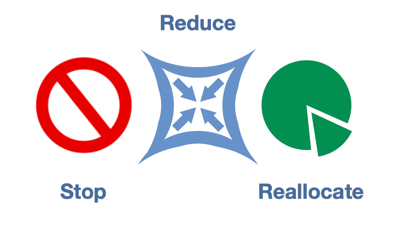The unprecedented rise of Covid-19 and subsequent government measures are triggering P&L warnings in businesses, globally and in every sector. Social distancing obligations are resulting in loss of contracts for supply, demand-driven and order fulfilment revenue losses, supply chain shortages, abnormal revenue phasing and reduced workforce utilisation.
In normal times, regular reviews of spend and committed cost is a normal and necessary activity. Right now, cutting costs has become an imperative to, in many cases, save the company.
Firms have, quite naturally, initiated short-term measures like discretionary spend cuts, deferred capital investment, put staff on furlough and made contingent workforce reductions. Similarly, cash management and forecasting have had much more focus.
What to do now
You already know that you need to rapidly re-calibrate costs to maintain business continuity. This forced right-sizing requires tailoring like no other cost reduction initiative, but one that demands open-minded flexibility to enable rapid bounce back on the return of regular trading conditions.
Action

1. Stop unnecessary spend
- Decide what to stop immediately – sith a change in demand, some customer-facing activities won't need to be performed.
- Re-assess how to perform back office activities – identify the activities which must be done regardless, and assess if they can be done in a different way. Use the saving to repurpose the workforce in these areas, either to alternate activities or to furlough. Implement the alternate activities.
- Scale-down work related to long-term contracts – assess the strength of relationship and future horizon of service operations. Reduce all associated servicing spend, and where possible re-allocate or re-purpose funds released for revenue generation, and for hyper-servicing your top, revenue generating customers.
2. Reduce spend to fit the current business
- In the short-term, prioritise existing customers over new business.
- Define your revenue-critical population – focus on retaining and enabling staff who are critical to 80% of your re-forecast revenue and fulfilment capability.
- Identify what services bring in what percentage of revenue and contribute to EBIT. Focus on the subset which generate 80% of income, and/or are crucial to regulators or to protect regulation.
- Proportionally scale the services to your revised revenue forecast and prepare further responses if forecast revenue drops and triggers further action.
- Determine if loss of scale will require completely new ways of working to ovide a similar service or is essential to provide any service at an affordable cost.
3. Reallocate spend for productivity
- Are we sufficiently flexible to capitalise when trading conditions resume? With cost cutting uppermost in our minds, we will be aiming to do the same with less. That's efficiency. Once we are through this challenging period, we won't want to cut further (we may not be able to cut further) so we'll then want to do more with the same. That's productivity. In another post we talk about ways of improving corporate and personal productivity.
- The interim operating model must enable rapid scaling – each part of your internal value chain must be ready to grow when conditions improve. Each should be able to flex unconstrained by their internal suppliers or customers, neither constrained within tolerance by HR or Finance. We discuss streamlining operations in another post.
- Assess contractor and outsourcing models – rapid scaling will be assisted by engaging external resource. The current situation will have made many capable people available and keen to return to a busy environment. Think ahead to how you will integrate them into your workforce, and start conversations with third-party providers well before you think that you will need them.
There are articles about how to get the best out of people, external and internal, in People Matter, in Team Culture and in Corporate Memory.
Keep an eye on the future
Assuming that your cost cutting and other measures will keep your company in buisness, then, well done, but consider that short-term actions will not suffice to ensure meaningful profitability for many firms. Analysis of past recessions has shown that it takes at least three years for manufacturing and the markets to recover from a deep financial crisis. Taking immediate reactive measures is inevitable, but, as the financial crisis 2008/2009 has shown, companies that implemented sustainable cost reduction programmes then significantly outperformed their competitors.
But this action only stabilises the patient. For a full recovery firms need to adopt structural performance improvement and digital transformation. Research shows that companies who took this approach during the Global Financial Crisis of 2008/09 significantly outperformed those which only focused on short-term cost cutting. The longer-term efforts performed well; many companies returned to pre-crisis EBIT levels in less than two years, at least a year ahead of those who didn't.
Take action
To avoid the scenario that the urgent constantly overrules the important, company executives will need to be bold and hire dedicated resource for the short-term cost-cutting cure and for the structural, sustainable solution. This way, organisations will start to experience the positive effects more quickly and gain an early advantage over their competition.
Next:
Structural Performance Improvement requires leaders to first have a clear target vision for the firm in three years' time. This should include the future core business model and operating model, but also define new pricing mechanisms and profitability targets.
A pre-requisite for this work is to know the value that is being created for the customer, to set the revised strategy and to ensure that the company's enterprise architecture both exists and is fit-for-purpose.
Based on this vision, the intiative to implement it will be to turn your company digital.





